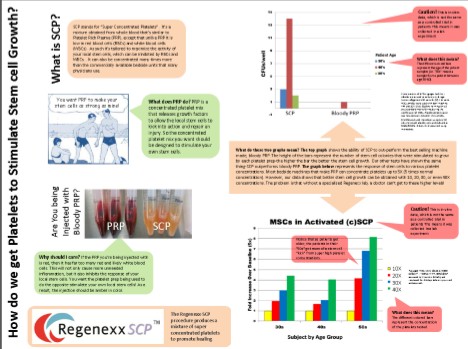PRP Injection Side Effects: Are You Being Injected With a Bloody PRP Catabolic Stew?
PRP is a mixture that contains concentrated blood platelets. We realized early on, that when training doctors on how to use our version of PRP (platelet rich plasma), they would ask us how we deal with PRP injection side effects, such a post-injection PRP flare-ups, which they claimed were quite severe.
At Regenexx, we weren’t really used to seeing this happen, but were surprised that many doctors would often have to medically manage these flares and PRP injection side effects.

What Was Causing Side Effects for Their PRP Mixtures?
Over time, we finally figured out that the red blood cell and white blood cell rich PRP that was being created by the automated bedside machines used by these doctors was what was causing the flare-ups. Because our PRP is carefully processed in a lab, it didn’t have many red or white blood cells, so we didn’t see these major flare-ups in our patients (click on the infographic above to see more info). We’ve also seen that this “bloodly PRP” (it looks red while ours looks amber) also inhibits stem cell growth, while our version dramatically increases stem cell growth in culture. The question is why?
Well a new study out this past week may help explain why. The study took the PRP most commonly produced from a bedside centrifuge and added it to stem cells derived from the knee. It turns out that the bloodly PRP produced nasty MMPs, which are cytokines known to harm cells and cartilage. In particular MMP-1 was increased by about 50 times, MMP-3 was elevated hundreds of times over baseline, and IL-6 about 50 times higher. What is MMP? This stands for Matrix Metalloproteinase, which is the name of a family of chemicals that breakdown cartilage. IL-6 stands for Interleukin-6, a pro-inflammatory cytokine that has been associated with arthritis. This makes sense as an explanation of why bloody PRP may be harming stem cells–it causes these nasty catabolic chemicals to be produced.
The upshot? Based on the data we have collected and after reviewing other publications., if the PRP that someone wants to inject you with is red, go elsewhere where the PRP is amber!

NOTE: This blog post provides general information to help the reader better understand regenerative medicine, musculoskeletal health, and related subjects. All content provided in this blog, website, or any linked materials, including text, graphics, images, patient profiles, outcomes, and information, are not intended and should not be considered or used as a substitute for medical advice, diagnosis, or treatment. Please always consult with a professional and certified healthcare provider to discuss if a treatment is right for you.
